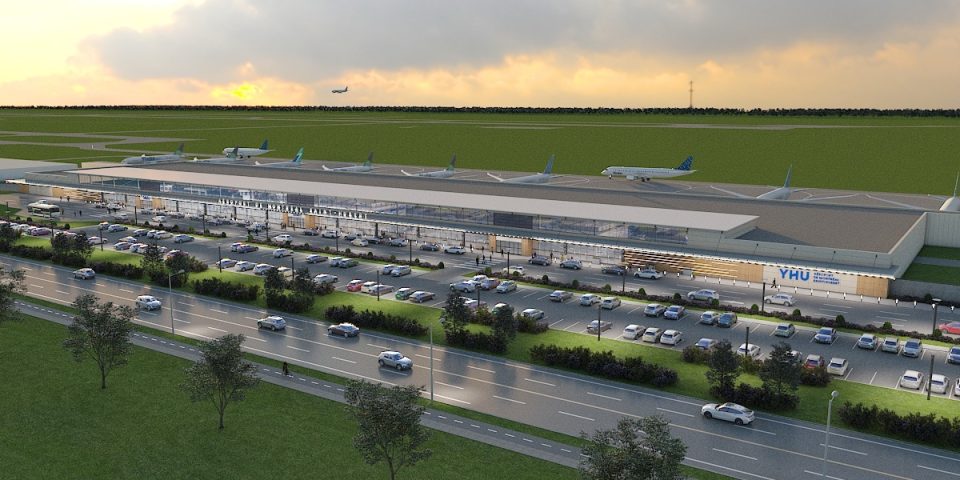The Canada Infrastructure Bank (CIB) is making historic investments in airport infrastructure across the country, committing more than $1.6 billion to enhance travel, trade corridors and stimulate economic growth. These investments span four airports and public transit expansion, with the largest loan being $1 billion to Aéroports de Montréal (ADM), for the transformation of Trudeau International Airport.
Trudeau Airport (YUL), Canada’s third busiest and a leader in international passenger traffic, is undergoing a 10-year capital plan to accommodate a projected 40% increase in passengers by 2036—from 25 million to 35 million. The expansion is expected to contribute $900 million annually to GDP.
ADM CEO Yves Beauchamp described the initiative as building “the airport of tomorrow.”
“Piece by piece, this strategic infrastructure is evolving. ADM’s projects at YUL will help advance Canada’s objectives of building a stronger, more competitive and resilient economy,” he said.
The phased expansion includes upgrades to parking, baggage handling, road networks, and terminal facilities, with completion targeted for 2034. By 2028, the infrastructure investments are projected to generate $3.7 billion in GDP and create up to 9,000 new jobs, adding to the 59,000 already supported by YUL in Quebec.
With the ADM restricted from raising equity capital, the CIB loan provides ADM with the financial flexibility to undertake an expansion of this magnitude without undue strain on its financial position.
For example, the loan includes provisions to defer interest payments during major adverse passenger disruptions, such as those experienced during the COVID-19 pandemic.
Complementing the airport’s transformation is the REM light rail extension, set to open in 2027. The CIB invested $300 million in the REM airport rail connection and station, in addition to $1.38 billion for the main network.
Another large-scale development is underway at Montreal Metropolitan Airport (formerly Saint-Hubert Airport ) on Montréal’s South Shore. A $90 million CIB loan is supporting the construction of a new nine-gate terminal led by Macquarie Asset Management and Porter Aviation Holdings Inc. This terminal is expected to accommodate up to 4.6 million domestic passengers annually, with Porter Airlines targeting to begin operations next year.
Porter is aiming to replicate its successful model at Billy Bishop Toronto City Airport, where it grew from 20,000 to 3 million passengers annually. The airline plans to serve at least 10 domestic markets and partner with Pascan Aviation to improve regional connectivity in Quebec.
According to Porter spokesperson Brad Cicero, the project will enhance competition, lower airfares, and create more than 400 jobs. He emphasized the CIB’s critical role in securing financing for the terminal, which will also help relieve congestion at Trudeau Airport and generate between $100 million and $525 million in annual GDP.
“Canada has limited financing options for aviation. The involvement of the CIB in this project made it possible to access the capital required to ensure this infrastructure project could move forward at the cost and timelines required for its success,” Cicero said.
By offering passengers more travel choices, the project is expected to reduce domestic air travel costs by introducing greater competition and attracting ultra low-cost carriers.
In Manitoba, the CIB is investing $52 million towards Thompson Regional Airport’s terminal replacement project, along with upgrades to taxiways, aprons, and access roads. The airport connects 37 northern communities—15 of which are Indigenous and accessible only by air or winter roads—and plays a vital role in delivering essential services and supporting industries like mining and tourism. This summer, the airport is playing a critical role to support emergency response to combat forest fires in northern Manitoba.
The new terminal, set for completion in early 2026, addresses the threat of permafrost-related subsidence that could have shut down operations.
“This project is a game changer for the region,” said airport CEO Curtis Ross.
It positions the airport as a modern hub for northern transportation and opens the door to expanded services, including new regional routes that boost economic activity across Manitoba’s North as well as a launch point for fighting forest fires.
In Alberta, Calgary International Airport is building a world-class aviation hub, which will comprise multiple facilities built over several phases and include a total of $172 million in CIB financing. Phase 1 of the project includes a new maintenance, repair and overhaul (MRO) facility. Lufthansa Technik, the facility’s anchor tenant, will operate a new engine repair station dedicated to LEAP engines, the next generation of reduced emissions aircraft engines. The facility will feature a first-of-its-kind in Canada test cell station, with operations expected to start in 2027. This state-of-the-art facility will address a gap in Canada’s aviation infrastructure by ensuring critical aircraft repair services are available domestically, rather than sending planes to international markets for routine services.
Chris Dinsdale, CEO of The Calgary Airport Authority, said traditional financing wasn’t viable and credited the CIB’s support with securing the project for Canada over competing international bids.
“In short, the CIB’s participation was not just helpful — it was essential,” Dinsdale said.
The CIB’s airport investments are a key driver of its trade and transportation sector to boost Canada’s economic growth by helping move goods and people more efficiently.
Canadian airports are significantly underfunded, having not received grants like their U.S. counterparts during COVID-19. Aging facilities now require substantial investment to expand and meet passenger demands over the next two decades, while some airports are creating new revenue streams or starting commercial flight operations from scratch.
The CIB addresses varying gaps by tailoring financing solutions to each airport’s unique needs. For the Montréal expansion, the CIB provided flexibility, including a relief valve for future market disruptions such as SARS or COVID-19.
“Our job is to work with the airports and figure out their needs and customize the product,” said Divya Shah, the trade and transportation sector’s managing director.







